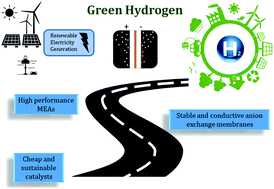Green hydrogen from anion exchange membrane water electrolysis: a review of recent developments in critical materials and operating conditions
Abstract
Hydrogen production using water electrolysers equipped with an anion exchange membrane (AEM), a pure water feed and cheap components such as platinum group metal-free catalysts and stainless steel bipolar plates (BPP) can challenge proton exchange membrane (PEM) electrolysis systems as the state of the art. For this to happen the performance of the AEM electrolyzer must match the compact design, stability, H2 purity and high current densities of PEM systems. Current research aims at bringing AEM water electrolysis technology to an advanced level in terms of electrolysis cell performance. Such technological advances must be accompanied by demonstration of the cost advantages of AEM systems. The current state of the art in AEM water electrolysis is defined by sporadic reports in the academic literature mostly dealing with catalyst or membrane development. The development of this technology requires a future roadmap for systematic development and commercialization of AEM systems and components. This will include basic and applied research, technology development & integration, and testing at a laboratory scale of small demonstration units (AEM electrolyzer shortstacks) that can be used to validate the technology (from TRL 2–3 currently to TRL 4–5). This review paper gathers together recent important research in critical materials development (catalysts, membranes and MEAs) and operating conditions (electrolyte composition, cell temperature, performance achievements). The aim of this review is to identify the current level of materials development and where improvements are required in order to demonstrate the feasibility of the technology. Once the challenges of materials development are overcome, AEM water electrolysis can drive the future use of hydrogen as an energy storage vector on a large scale (GW) especially in developing countries.

- This article is part of the themed collection: Energy Frontiers: Hydrogen


 Please wait while we load your content...
Please wait while we load your content...